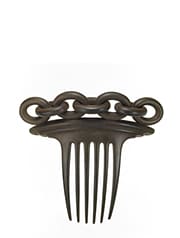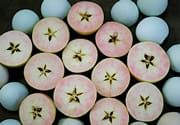NOVEMBER 2019
Hello friends,
Just about six more weeks before we wave goodbye to this lovely year. This month is all about gratitude and the next is for reflection (especially that final week). I'm thinking about my ceremony of thanks. Each day is better than the last. Turning inward and working on myself this year allowed me to rethink & refine my goals. I'm proud of me. I did well and the year isn't over yet. As the subway spits me out onto the block every morning, the soundtrack in my head is the Rocky theme song.
Literally.Living.My.Dream.Every.Day.
I'm a compulsive list maker and will shamelessly journal lists with titles like: Dope Shit I Did this Month.
I fervently hope each of you feels the same way when you look back upon this month, if not year. Write a wishful list if there are things you're still waiting on. Conjure them into being by writing them down.
GEM QUALITY PINK SAPPHIRE
Now this is an electric pink sapphire. Hot pink or bust.
This rectangular-cut pink sapphire is an acidic, neon pink. It's a clean stone, and I love the cut. Small table, and high crown angles. Chunky & voluptuous. It weighs approximately 3.54 carats and would be perfect for a ring. Only so you could admire it all day.
Speaking of ring, I would incorporate these pear-shaped pink sapphires, which are skinny and long, and create a balance/contrast to the rectangular cut. The background is 'Toile de Jouy' tissue paper that I could not bring myself to discard. That's a picnic I'd like to attend. Picking sapphires off trees like fruit while picnicking actively. Yes please, and thank you.
DENDRITIC AGATE, FANCY-COLORED DIAMOND
AND GOLD NECKLACE
I've had this sumptuous plaque of dendritic agate since 2016 and it has been through many iterations. I thought it would make a wonderful swag necklace, and cut a series of smaller plaques to match. We created the settings and the clasp at great expense but at the last minute, I abandoned the entire design. All the castings were sent back to be refined and I began again. Something didn't feel right; that design felt too heavy and formal. Jewelry should be worn and enjoyed frequently, if not daily. So I pared the design way down into a frame for the 'painting'.
The fern-like or seaweed structures you see are a mineral known as dendrites growing within the host rock of agate. This scene reminds me of the paintings from the Hudson River School. I love the way the frame turned out, with the weeping willow branch draped over the frame, further accented with canary-colored diamonds. But I could not figure out how to hang the chain. I have an extensive jewelry library and frequently leaf through my books before I sleep so that my dreams are populated by anthropomorphized gems and jewels. A Wiener Werkstätte pendant by Eduard Josef Wimmer-Wisgrill dated 1914 was just the design inspiration I needed. The necklace is done. Please stop by and try it on. It begs to be worn.
When I think to where I first started in the jewelry business, and then look at this jewel, my heart is so full.
RUBY, ONYX AND ENAMEL EAR PENDANTS


My love affair with Renaissance jewelry rages on. After finishing the petal ring and earrings, I wanted to explore enamel. These ear pendants are set with tumbled, unheated Burma rubies, each suspending a black onyx drop, surmounted by an 18K gold and black enamel cap. The rubies glow like coals, as do I when I wear them. I'm playing with a variety of other designs with different enamel colors: bluish grey chalcedony with pale periwinkle spinel and white enamel next.
And speaking of enamel, I'm interested in taking Valerie Blum's enameling class at Jewelry Arts Institute, and we need a minimum of three more people to run the class. If anyone is interested in an Introduction to Enamel weekend class in mid-March, please reach out to me. It would be two full days over a weekend.
MULTI-COLORED UNHEATED SAPPHIRE
AND SPINEL PARCELS
These parcels are all multi-colored sapphires in different shapes and sizes. The pink material in the bottom right hand corner are all spinel. The photo is noteworthy because every stone in this photo is natural color and untreated. The only human intervention has been the polishing process—faceting the stone.
It's lovely to start the holiday season with fresh, full palettes to draw from. Magic fairy dust for the jeweler.
STRANDS OF TAHITIAN CULTURED PEARLS
A simple strand of pearls is so elegant. I adore Nancy Pelosi for her seemingly endless collection of gorgeous gobstopper strands that are her signature style. There's a woman who knows her style and won't be following a trend anytime soon. Fresh.
I do wonder what her jewel box(es) look like.
These eggshells are from the farmer's market at Grand Army Plaza in Brooklyn, and I just can't bring myself to throw them away. They are so achingly beautiful.


Braiding Sweetgrass: Indigenous Wisdom, Scientific Knowledge and the Teachings of Plants by Robin Wall Kimmerer is non-fiction, but also a love letter to nature. Both Owens and Wall Kimmerer use words in lyrically different ways. Owens conjures a marsh and the world held within, down to the tiniest creatures and plants. Wall Kimmerer uses words to spin a song of love and longing.
These are just two passages from Braiding Sweetgrass that I have copied into my journal so far:
“Ceremonies large and small have the power to focus attention to a way of living awake in the world.” pg. 36 [Emphasis mine.]
The botanical word porn in this book is intoxicating. Here's three for a soupçon of titillation: Libum, petiole, and aerenchyma. A libum is the wee little eye of a bean. A petiole attaches a leaf to the stem, and aerenchyma is the botanical term for the spongy pith found in some plants (in particular aquatic plants).
On the word puhpowee: “I stumbled upon it in a book by the Anishanaabe ethnobotanist Keewaydinoquay, in a treatise on the traditional uses of fungi by our people. Puhpowee, she explained, translates as 'the force which causes mushrooms to push up from the earth overnight.' As a biologist, I was stunned that such a word existed.”

Gobble Gobble,


















Leave a comment (all fields required)